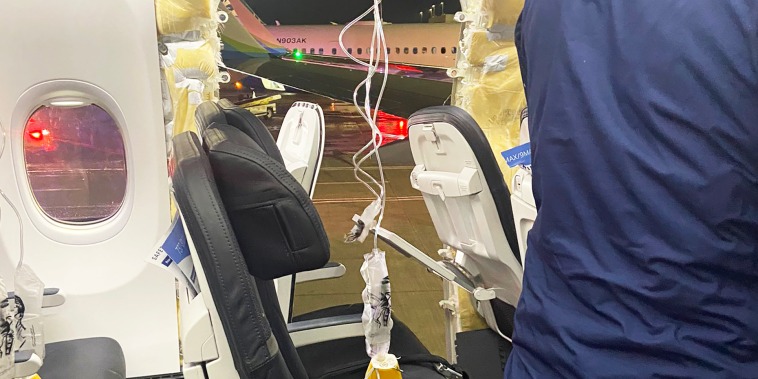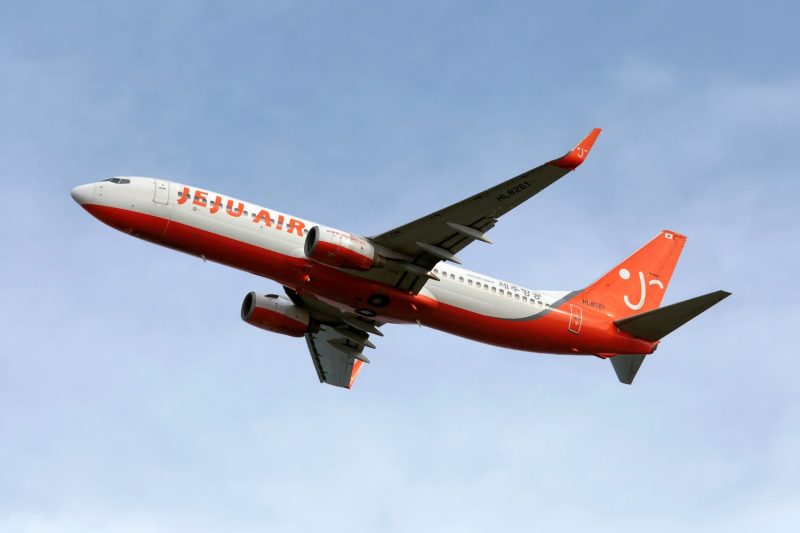‘Stakes are high’ in the Alaska Airlines flight inquiry, NTSB chair says

The ‘stakes are high’ in the investigation into the Alaska Airlines flight that was forced to make an emergency landing when a panel of the Boeing plane blew out midair, according to the chair of the National Transportation Safety Board.
Sunday was the first full day of the NTSB investigation into the incident on Friday.
‘We will be looking at the entire chain of the events, from production to putting this plug in service to what happened to the history of this particular aircraft in flight and in service from the start to where we are today,’ Jennifer Homendy told NBC News on Sunday.
Sunday’s process has involved speaking with the flight crew, Homendy said, and the plane’s so-called black boxes have been sent to Washington, D.C., for review.
In a message sent to employees Sunday, Boeing President and CEO Dave Calhoun said an all-employee meeting focused on safety would be held Tuesday. He also canceled a leadership summit that was set to take place on Monday and Tuesday so the company can focus its attention to the NTSB investigation.
Homendy said investigators will also look into pressurization alerts that went off on the plane during flights Wednesday and Thursday, the days before the accident. She said her team was informed of the alerts but is still waiting for confirmation from Alaska Airlines.
She added the NTSB was told the alerts were ‘pretty benign’ but said her team is ‘digging into’ them.
Homendy described the ‘violent’ and ‘chaotic’ explosion of the door plug and noted that the situation could have been far more dire had the plane been at cruising altitude, about 35,000 feet.
‘This could have been a catastrophic, catastrophic event,’ she said. ‘This is why we go to incidents, why we go to accidents, when there aren’t fatalities, when there aren’t injuries, because we want to make sure that the public is aware of what’s occurring and that we’re taking a look and that we want to prevent this from reoccurring.’
She said Boeing is working closely with the NTSB to uncover what happened and to prevent it from happening again.
‘We will not stop until we get to the bottom of what has occurred and what led to this,’ Homendy said.
The Federal Aviation Administration has ordered the grounding of some Boeing 737 Max 9 airplanes, the model flown in the Alaska Airlines incident, after a retrofitted door panel detached at roughly 16,000 feet in the air Friday.
On Saturday, the FAA issued a directive that requires operators to inspect certain Boeing 737 MAX 9 aircraft before they can be flown again. The process is estimated to take four to eight hours per aircraft, affecting 171 planes worldwide.
The agency said Sunday the aircraft ‘will remain grounded until the FAA is satisfied that they are safe.’
The European Union Aviation Safety Agency adopted the FAA order but noted that the specific configuration of the model was not widely used in Europe, and no flights have been grounded as a result.
According to the NTSB, the part of the plane that detached was a plug door, which creates a seal where an emergency door would be in configurations with higher passenger capacity. From the inside of the plane, it would appear to be a normal window seat, but it appears in the shape of a door from the exterior.
The door plug has not been recovered.
There were no serious injuries or deaths, the NTSB has said, because of the plane’s relatively low altitude when the incident occurred and the fact that two seats by the panel were vacant. The NTSB said it happened about 10 minutes after the flight departed the Portland, Oregon, airport en route to San Bernardino County, California.
Jeff Guzzetti, a former investigator for the FAA and the NTSB, said the federal investigation will probe not only the cause of Friday’s incident but also whether it was a flaw caused during production that might have been more widespread.
‘This is an issue of life or death,’ Guzzetti said. ‘This is why aviation redundancy is so critical, why quality control is so critical, because even a small mistake, if this was a mistake, like misplaced bolt or something like that, that can lead to death and injury. … We have to nail down the process of what happened here.’
The issue appears to be, in Guzzetti’s opinion, a ‘quality escape,’ or, in other words, a part that gave way, which caused the plug to dislodge.
‘All manufacturers are going to have problems like this. It’s just a matter of how often they occur and how serious they are,’ Guzzetti said. ‘But yes, even an incident like this that doesn’t involve any injuries or fatalities does serve to undermine to some degree the confidence in Boeing’s ability to manufacture safe aircraft.’
Homendy has not speculated on a cause.
The plane used Friday was delivered a little over two months before the accident, the NTSB and Alaska have said.
John Cox, a former pilot and accident investigator, examined photos and said it appeared that all eight pins that attach the plug door to the plane were intact. The question then becomes, he told NBC News, whether the bolts were at fault.
‘There are four bolts that hold that plug in place,’ Cox said. ‘And why … why didn’t they do their job? Were they — was it an improper installation? Were they not properly torqued? Did they not have the proper hardware? All of those questions are the things that the investigators are going to look at.’
Cox recalled that Boeing made promises a few years ago to improve its quality assurance process after two fatal crashes in 2018 and 2019 that killed a total of 346 people, both of which also involved 737 Max models.
A congressional investigation released in September 2020 found that the crashes were “a horrific culmination of a series of faulty technical assumptions by Boeing’s engineers, a lack of transparency on the part of Boeing’s management, and grossly insufficient oversight by the FAA.’
It’s important for both passengers and airline operators to get answers about what happened to cause Friday’s accident, whether it was a one-off issue or a result of systemic breakdowns.
‘It certainly does not help the reputation of Boeing to go out into the world and sell new airplanes and for the operators to feel good that they’re not going to have an interruption or, worse, a safety issue that they have to deal with … because Boeing may build the airplane, but it’s the operators — they end up having to deal with the consequences,’ Cox said.



